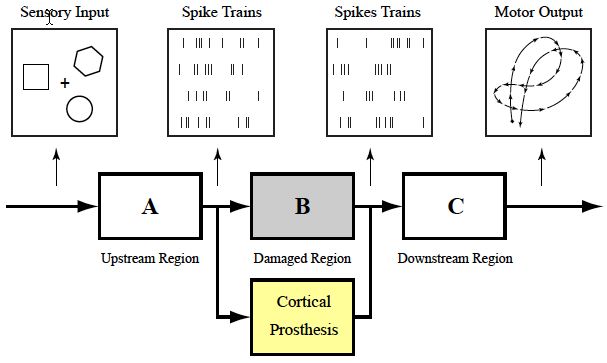“That makes Veritas the first company to break the much anticipated threshold of a “$1,000 genome.” Mirza Cifric, Veritas’s CEO, confirmed that, initially at least, the new price is less than the cost of actually generating the data, when equipment and chemical supplies are included.”
Cortical memory prosthesis uses internal brain signals (e.g., spiketrains) as inputs and outputs, bypassing damaged region (Dong Song et al.)
A brain prosthesis designed to help individuals suffering from memory loss has been developed by researchers at USC and Wake Forest Baptist Medical Center.
A few weeks ago, a drunk man in Japan was arrested for kicking a humanoid robot that was stationed as a greeter at a SoftBank, Corp., store, which develops the robots. According to the police report, the man said he was angry at the attitude of one of the store clerks. The “Pepper robot” now moves more slowly, and its internal computer system may have been damaged.
Under current Japanese law, the man can be charged with damage to property, but not injury, since injury is a charge reserved for humans. Dr. Yueh-Hsuan Weng, who is cofounder of the ROBOLAW.ASIA Initiative at Peking University in China, and former researcher of the Humanoid Robotics Institute at Waseda University in Japan, thinks a better charge lies somewhere in between.
Weng is advocating for special robot laws to address the unique nature of human-robot interactions. He argues that humans perceive highly intelligent, social robots like Pepper (which can read human emotions) differently than normal machines—maybe more like pets—and so the inappropriate treatment of robots by humans should be handled with this in mind.
BioViva USA, Inc. has become the first company to treat a person with gene therapy to reverse biological aging, using a combination of two therapies developed and applied outside the United States of America. Testing and research on these therapies is continuing in BioViva’s affiliated labs worldwide.
BioViva CEO Elizabeth Parrish announced Biobthat the subject is doing well and has resumed regular activities. Preliminary results will be evaluated at 5 and 8 months with full outcome expected at 12 months. The patient will then be monitored every year for 8 years.
Gene therapy allows doctors to treat disease at the cellular level by inserting a gene into a patient’s cells instead of using the regular modalities of oral drugs or surgery. BioViva is testing several approaches to age reversal, including using gene therapy to introduce genes into the body.
Do any existing drugs have longevity promoting effects? Here are 3 currently under investigation.
Scientists funded by the NIH BRAIN Initiative hope to diagram all of the circuits in the brain. One group will attempt to identify all of the connections among the retina’s ganglion cells (red), which transmit visual information from bipolar cells (green) and photoreceptors (purple) to the brain. (credit: Josh Morgan, Ph. D. and Rachel Wong, Ph. D./University of Washington)
The National Institutes of Health and the Kavli Foundation separately announced today (Oct. 1, 2015) commitments totaling $185 million in new funds supporting the BRAIN Initiative — research aimed at deepening our understanding of the brain and brain-related disorders, such as traumatic brain injuries (TBI), Alzheimer’s disease, and Parkinson’s disease.
IBM scientists take a big step toward their quest to bring us speedy, low-power chips. The secret: carbon nanotubes.
A propensity to worry indicates a strong ability to consider the past and future in precise detail, perhaps explaining why worriers also tend to be more intelligent.
While worriers have often been considered a liability to groups of professionals and friends alike, due to their apparent lack of confidence, they may be better at learning from past mistakes than others, and preparing for future threats.
Researchers have recently found that worriers are better at telling when others are lying and are quicker at detecting threats, such as smoke in the room caused by a fire elsewhere. Now, a survey of one hundred students at MacEwan University has shown that worrying goes hand in hand with having a higher intelligence.








